Recently my good friend and mentor gerda mentink (1941-2015), formerly the cultural motor of the Goethe-Institut Amsterdam, suddenly died. In loving memory of her, I share these beautiful postcards of the silent classic Faust (F.W. Murnau, 1926) with you. Together with gerda, I made an exhibition on Murnau for the Nederlands Filmmuseum (now Eye Film Institute) in 1990. For the poster we used an image of Faust. gerda, rest in peace.

German postcard by Ross Verlag, no. 62/4. Photo: ParUfaMet / Ufa. Still with Gösta Ekman and Emil Jannings in Faust (1926). Collection: Didier Hanson.
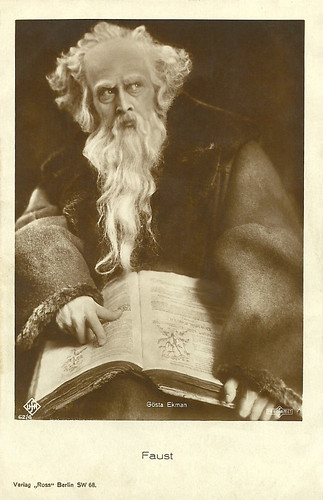
German postcard by Ross Verlag, no. 62/6. Photo: ParUfaMet / Ufa. Still with Gösta Ekman in Faust (1926). Collection: Didier Hanson.
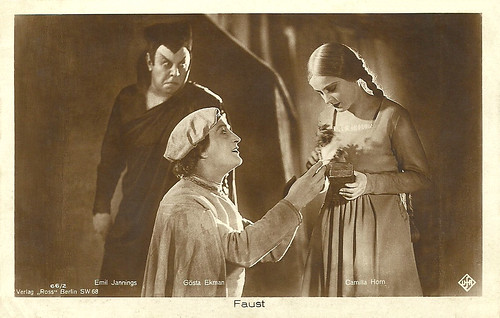
German postcard by Ross Verlag, no. 66/2. Photo: Ufa. Still with Gösta Ekman, Emil Jannings and Camilla Horn in Faust (1926). Collection: Didier Hanson.
Faust – Eine deutsche Volkssage/Faust (1926) still is one of my favourite films. It is an overwhelming spectacle of unparalleled camera work and beautiful scenery.
Faust is one of the highlights of the silent European cinema and the last in a series of classics directed by Friedrich Wilhelm Murnau for the Ufa studios in Babelsberg.
In 1926, Faust was the most expensive European film ever. Filming took six months and a cost of 2 million. You can see why, there are many spectacular scenes.
Wonderful is the scene where Mephisto takes Faust flying along on his magic cloak for a dizzying trip. In an enchanting, seemingly endless camera movement we follow Mephisto and his victim over nocturnal landscapes, narrowly skimming along spiers and peaks. This kind of prospects were never seen before in the cinema.
Faust showed what was possible in the Ufa studios in Babelsberg. The set was built in a studio of 20 by 35 meters. The camera was added with a motor as a sort of rail-roller coaster. The scenery and camera movement give us the feeling that the camera flies.
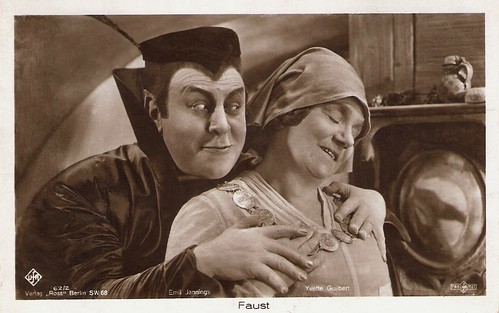
German postcard by Ross Verlag, no. 62/2. Photo: ParUfaMet / Ufa. Still with Emil Jannings as Mephisto and Yvette Guilbert as Marthe in Faust (1926).
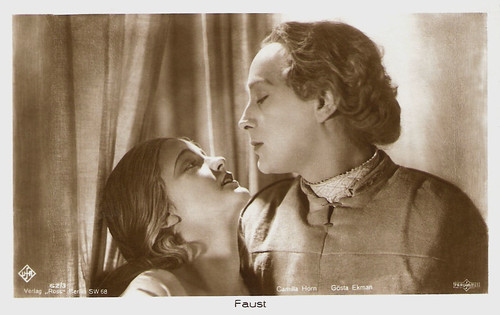
German postcard by Ross Verlag, no. 62/3. Photo: Ufa. Publicity still for Faust (Friedrich Wilhelm Murnau, 1926) with Camilla Horn and Gösta Ekman.
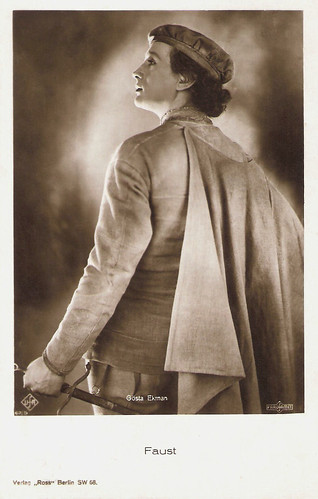
German postcard by Ross Verlag, no. 62/5. Photo: ParUfaMet / Ufa. Still with Gösta Ekman as the young Faust in Faust (1926).
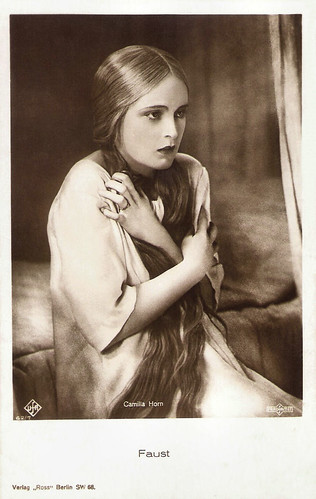
German postcard by Ross Verlag, no. 62/7. Photo: Ufa. Publicity still for Faust (Friedrich Wilhelm Murnau, 1926) with Camilla Horn.
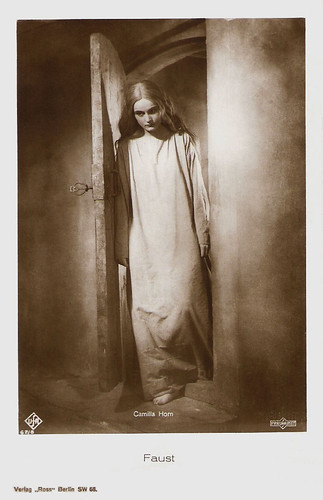
German postcard by Ross Verlag, no. 62/8. Photo: ParUfaMet / Ufa. Still with Camilla Horn as Gretchen for Faust (1926).
The title figure Faust is played by the Swedish star Gösta Ekman. With his boyish good looks, Ekman was able to captivate his audiences, of both sexes.
The innocent girl Gretchen was played by a young and inexperienced dancer, the ethereally blonde Camilla Horn. Her film debut would be the start of a long and impressive career.
Gretchen’s aunt Marthe was portrayed by the legendary French actress Yvette Guilbert.
And then there was Emil Jannings, who had worked with Murnau before at Der Letzte Mann/The Last Laugh (F. W. Murnau, 1924) and at Herr Tartüff/Tartuffe (F.W. Murnau, 1925). He now played the plum role of the demon Mephistoteles. Jannings is hilarious as the evil tempter and draws all attention to himself.
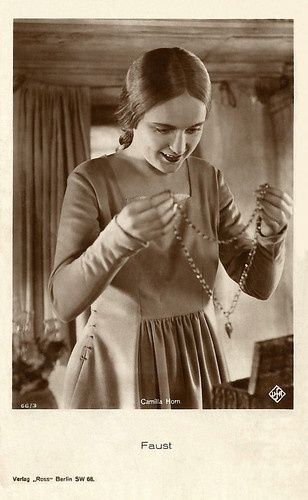
German postcard by Ross Verlag, no. 66/3. Photo: ParUfaMet / Ufa. Still with Camilla Horn as Gretchen for Faust (1926).

German postcard by Ross Verlag, no. 66/6. Photo: Ufa. Publicity still for Faust (1926) with Camilla Horn and Gösta Ekman.

German postcard by Ross Verlag, no. 66/7. Photo: Ufa. Publicity still for Faust (Friedrich Wilhelm Murnau, 1926) with Camilla Horn and Frieda Richard.
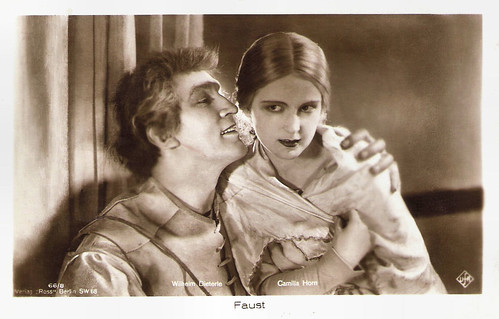
German postcard by Ross Verlag, no. 66/8. Photo: Ufa. Publicity still for Faust (1926) with Wilhelm Dieterle and Camilla Horn.
The theme of the film is the struggle between light and dark. Faust opens with a prologue in heaven with the metaphysical battle between the devil and the archangel.
We see a blinding entanglement of light and dark areas that try to push each other away. Mephisto has a bet with the archangel that he can corrupt an honest man's soul and destroy in him what is divine.
Later the demon wraps the town with his dark cloak. He sends black smoke into the streets and thus poisons the inhabitants with the plague.
The old and learned alchemist Faust can’t do anything against the misery of the plague. Deeply disappointed, he sells his soul to Mephisto to relive his youth. Mephisto loads Faust with power and wealth, but despite this all he fails to destroy the divine in Faust’s soul.
Faust’s love for Gretchen triumphs over all. The film ends with the rotating beams of the sun that link to hope and redemption.
Restored Deluxe Edition DVD Trailer of Faust (1926). Source: Kino International (YouTube).
The magic carpet ride from Faust, scored at Dartington International Summer Festival. Source: Andrew Fingers (YouTube).
Sources: Wikipedia and IMDb.

German postcard by Ross Verlag, no. 62/4. Photo: ParUfaMet / Ufa. Still with Gösta Ekman and Emil Jannings in Faust (1926). Collection: Didier Hanson.

German postcard by Ross Verlag, no. 62/6. Photo: ParUfaMet / Ufa. Still with Gösta Ekman in Faust (1926). Collection: Didier Hanson.

German postcard by Ross Verlag, no. 66/2. Photo: Ufa. Still with Gösta Ekman, Emil Jannings and Camilla Horn in Faust (1926). Collection: Didier Hanson.
A Dizzying Trip
Faust – Eine deutsche Volkssage/Faust (1926) still is one of my favourite films. It is an overwhelming spectacle of unparalleled camera work and beautiful scenery.
Faust is one of the highlights of the silent European cinema and the last in a series of classics directed by Friedrich Wilhelm Murnau for the Ufa studios in Babelsberg.
In 1926, Faust was the most expensive European film ever. Filming took six months and a cost of 2 million. You can see why, there are many spectacular scenes.
Wonderful is the scene where Mephisto takes Faust flying along on his magic cloak for a dizzying trip. In an enchanting, seemingly endless camera movement we follow Mephisto and his victim over nocturnal landscapes, narrowly skimming along spiers and peaks. This kind of prospects were never seen before in the cinema.
Faust showed what was possible in the Ufa studios in Babelsberg. The set was built in a studio of 20 by 35 meters. The camera was added with a motor as a sort of rail-roller coaster. The scenery and camera movement give us the feeling that the camera flies.

German postcard by Ross Verlag, no. 62/2. Photo: ParUfaMet / Ufa. Still with Emil Jannings as Mephisto and Yvette Guilbert as Marthe in Faust (1926).

German postcard by Ross Verlag, no. 62/3. Photo: Ufa. Publicity still for Faust (Friedrich Wilhelm Murnau, 1926) with Camilla Horn and Gösta Ekman.

German postcard by Ross Verlag, no. 62/5. Photo: ParUfaMet / Ufa. Still with Gösta Ekman as the young Faust in Faust (1926).

German postcard by Ross Verlag, no. 62/7. Photo: Ufa. Publicity still for Faust (Friedrich Wilhelm Murnau, 1926) with Camilla Horn.

German postcard by Ross Verlag, no. 62/8. Photo: ParUfaMet / Ufa. Still with Camilla Horn as Gretchen for Faust (1926).
Evil Tempter
The title figure Faust is played by the Swedish star Gösta Ekman. With his boyish good looks, Ekman was able to captivate his audiences, of both sexes.
The innocent girl Gretchen was played by a young and inexperienced dancer, the ethereally blonde Camilla Horn. Her film debut would be the start of a long and impressive career.
Gretchen’s aunt Marthe was portrayed by the legendary French actress Yvette Guilbert.
And then there was Emil Jannings, who had worked with Murnau before at Der Letzte Mann/The Last Laugh (F. W. Murnau, 1924) and at Herr Tartüff/Tartuffe (F.W. Murnau, 1925). He now played the plum role of the demon Mephistoteles. Jannings is hilarious as the evil tempter and draws all attention to himself.

German postcard by Ross Verlag, no. 66/3. Photo: ParUfaMet / Ufa. Still with Camilla Horn as Gretchen for Faust (1926).

German postcard by Ross Verlag, no. 66/6. Photo: Ufa. Publicity still for Faust (1926) with Camilla Horn and Gösta Ekman.

German postcard by Ross Verlag, no. 66/7. Photo: Ufa. Publicity still for Faust (Friedrich Wilhelm Murnau, 1926) with Camilla Horn and Frieda Richard.

German postcard by Ross Verlag, no. 66/8. Photo: Ufa. Publicity still for Faust (1926) with Wilhelm Dieterle and Camilla Horn.
Light and Dark
The theme of the film is the struggle between light and dark. Faust opens with a prologue in heaven with the metaphysical battle between the devil and the archangel.
We see a blinding entanglement of light and dark areas that try to push each other away. Mephisto has a bet with the archangel that he can corrupt an honest man's soul and destroy in him what is divine.
Later the demon wraps the town with his dark cloak. He sends black smoke into the streets and thus poisons the inhabitants with the plague.
The old and learned alchemist Faust can’t do anything against the misery of the plague. Deeply disappointed, he sells his soul to Mephisto to relive his youth. Mephisto loads Faust with power and wealth, but despite this all he fails to destroy the divine in Faust’s soul.
Faust’s love for Gretchen triumphs over all. The film ends with the rotating beams of the sun that link to hope and redemption.
Restored Deluxe Edition DVD Trailer of Faust (1926). Source: Kino International (YouTube).
The magic carpet ride from Faust, scored at Dartington International Summer Festival. Source: Andrew Fingers (YouTube).
Sources: Wikipedia and IMDb.
1 comment:
I will have to check this out for sure! Thanks Bob
Post a Comment